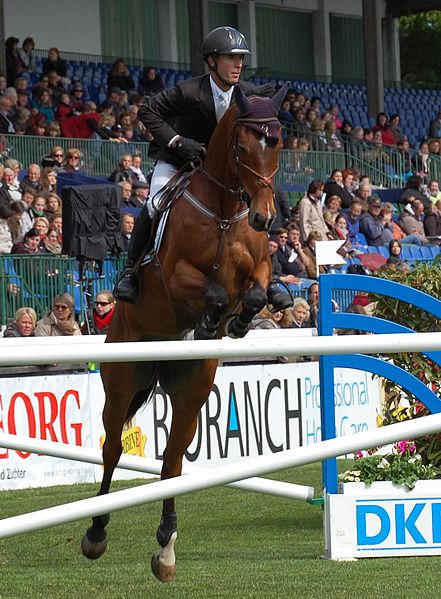At multi-day shows, professional braiders are seen braiding through the night and morning (they can be recognized by their braiding belts overflowing with cut yarn, their ever-present foldable step stools and their looks of exhaustion by the end of the morning). They are available to braid horses who are stabled on-site, and occasionally those who ship in early enough and have a suitable workspace for them. For single-day shows, professionals can be someone within your barn or someone who is willing to travel from barn to barn in the area to braid.
Braiders often start taking bookings before the show season begins, and some can book up early unless they hire other braiders to handle their overflow. For this reason it's important to find a braider as early as you can; you can't guarantee that the best ones will have spots available for you at the last minute.
There are several ways in which you could find a professional braider prior to (or at) a horse show. The best, in my opinion, is through word of mouth. Anyone can call themself a professional braider; there is no guarantee of quality. If you ask others who they use and are happy with, you have a better chance of finding someone who will do a good job. Here are the main ways to find a braider, in order of my personal preference:
Word of mouth
Simply put, ask others which braiders they prefer to use. If you don't know anyone to ask, most grooms and riders are quite happy to recommend good braiders so don't hesitate to ask someone you're stabled beside, in line with you at the show office, etc. This method will also catch those braiders who are so popular that they don't always need to advertise. You might also be able to see a braider at work in the morning and inquire about their availability later in the week or for a future show if you like the quality of their work.
Advertisement at a show
Some braiders will put up signs at the show office, on bulletin boards or on walls in high traffic areas. These signs often include sample photos of braids and convenient tabs that you can rip off with the braider's contact information. While none of this is any guarantee of quality, a physical advertisement shows that the braider actually visits the show venues and isn't someone just hoping to get enough clients to be able to make it out to the show.
Advertisement online
Braiders will sometimes advertise on social media, either in groups for geographical horsey areas/show circuits, or on pages devoted to the individual horse shows. While you can ask for sample photos, there is a risk when they're viewed privately that the photos are not that braider's work. Also, anyone can post an ad hoping to get clients, which makes it a favourite option for those just starting out who might not have yet perfected their craft.
You can also post a "wanted" ad online, but you again have no surefire way of vetting those who respond.
Once you've found a braider, you'll need to contact them and ask whether they are available for your horse show. The braider must be told which days your horse needs to be braided for, as well as which division you'll be showing in (in order to schedule which horses need to be done first). You will also need to give the horse's location (so that they will not be forced to wander around the showgrounds searching for your stalls) and name (which you should clearly mark on the stall so that the correct horse will be braided!). Be sure to also let the braider know if the horse's mane is in need of pulling or shortening so that can be worked into their schedule.
If there is anything that the braider will need from you, such as a fake tail, tail wrap or neck cover, leave it in a clean, accessible place and tell the braider about it; they're not mind-readers!
Anything that happens to your horse once braided is not the braider's responsibility. While some styles of braiding might be more itchy than others, a braid rubber is usually a braid rubber and the braider can't be expected to go around looking for and fixing rubbed-out braids throughout the day. Also, the removal of the braids is your job, so keep a seam ripper on hand (cutting through the yarn strands crossed underneath a braid will often be enough to unravel the whole thing).
Most braiders will come around in the morning following their braiding to collect money so that cash isn't being left out during the night to potentially be stolen. While it's possible to miss the braider for a day or two if you're away from your stalls, try to pay as promptly as you can. Braiders work hard and the last thing that they need to be doing after hour upon hour of braiding is chasing people around the showgrounds. If you have trustworthy people who will usually be present at your stalls, find a safe place to put the cash there and ask them to give it to the braider if she comes around while you're at the show ring.




